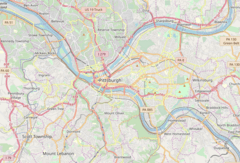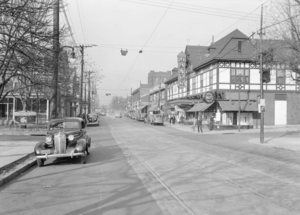Squirrel Hill facts for kids
Quick facts for kids
Squirrel Hill
|
|
|---|---|
|
Neighborhood of Pittsburgh
|
|
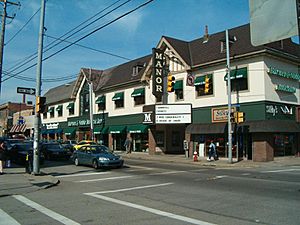
Murray Avenue in Squirrel Hill in 2005
|
|
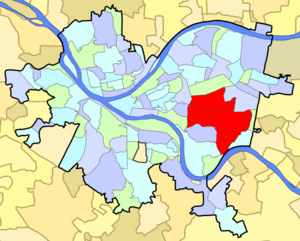
Location within the city of Pittsburgh
|
|
| Country | |
| State | |
| County | Allegheny County |
| City | Pittsburgh |
| Area | |
| • Total | 3.89 sq mi (10.1 km2) |
| Population | |
| • Total | 27,196 |
| • Density | 6,800/sq mi (2,600/km2) |
|
Squirrel Hill North
|
|
|---|---|
|
Neighborhood of Pittsburgh
|
|
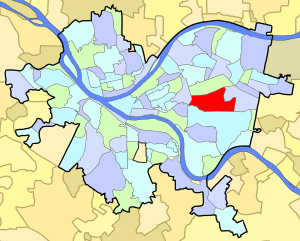 |
|
| Area | |
| • Total | 1.222 sq mi (3.16 km2) |
| Population
(2020)
|
|
| • Total | 11,879 |
| • Density | 9,721/sq mi (3,753.3/km2) |
|
Squirrel Hill South
|
|
|---|---|
|
Neighborhood of Pittsburgh
|
|
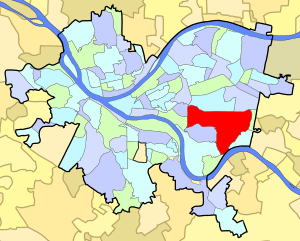 |
|
| Area | |
| • Total | 2.671 sq mi (6.92 km2) |
| Population
(2020)
|
|
| • Total | 15,317 |
| • Density | 5,734.6/sq mi (2,214.1/km2) |
| Location | 1010–1201 Murray Hill Avenue (Squirrel Hill), Pittsburgh, Pennsylvania, USA |
|---|---|
| Coordinates | 40°26′59″N 79°55′41″W / 40.449669°N 79.928119°W |
| CPHD designated | April 3, 2000 |
| PHLF designated | 2004 |
Squirrel Hill is a lively neighborhood in the East End of Pittsburgh, Pennsylvania, United States. Even though the city divides it into two parts, Squirrel Hill North and Squirrel Hill South, most people think of it as one big neighborhood.
Contents
Where is Squirrel Hill?
Squirrel Hill is located in Pittsburgh, Pennsylvania. It has two main ZIP codes: 15217 and 15232.
Neighboring Areas
Squirrel Hill North shares its borders with five other Pittsburgh neighborhoods. These include Shadyside to the north and Point Breeze to the east. It also borders Squirrel Hill South to the south. To the southwest is Central Oakland, and to the west is North Oakland.
Squirrel Hill South has even more neighbors, with nine land borders. It touches Squirrel Hill North to the north and northwest. To the northeast is Point Breeze, and to the east is Regent Square. Other neighbors include Swisshelm Park to the southeast, and Glen Hazel and Hazelwood to the south-southwest. Greenfield is to the southwest, and South Oakland and Central Oakland are to the west. Across the Monongahela River to the south-southeast, Squirrel Hill South is close to Homestead.
Who Lives in Squirrel Hill?
In 2010, Squirrel Hill North had about 11,363 people living there. Its population grew by 9% since 2000. Most residents (75%) are White, 17% are Asian, 4% are Hispanic, and 3% are Black. About 93% of the homes in Squirrel Hill North are lived in.
Squirrel Hill South had about 15,110 people in 2010, which was a 4% increase since 2000. Here, 82% of residents are White, 11% are Asian, 3% are Hispanic, and 3% are Black. About 95% of the homes in Squirrel Hill South are occupied.
A Hub for the Jewish Community
Around 40% of the people in Squirrel Hill were Jewish in 2010. A study from 2002 showed that 33% of all Jewish people in the Greater Pittsburgh area live in Squirrel Hill. Another 14% live in the nearby neighborhoods. This makes Squirrel Hill a special place in North America because it's a strong center for the Jewish community within a city.
Growing Asian Community
Squirrel Hill is also becoming a new Chinatown for Pittsburgh. Many students from mainland China who attend Carnegie Mellon University have moved to the area. Each year, the community celebrates Chinese New Year with a parade. In 2017, about 17% of the people living in Squirrel Hill were of Asian descent.
A Look Back: Squirrel Hill's History
The name "Squirrel Hill" might have come from the Native Americans who lived here long ago. It was probably named because there were so many black squirrels in the area.
Early Settlements
The first homes in Squirrel Hill were built near the Monongahela River. Colonel James Burd, a soldier from nearby Fort Pitt, built a house in 1760. Another early house, built by Ambrose Newton in the 1760s, is still standing in what is now Schenley Park.
In 1778, John Turner built his large estate called Federal Hill. He later created the Turner cemetery in 1838 on his land, which he gave to the community. Many of Squirrel Hill's first settlers are buried there. The Mary S. Brown Memorial Methodist church, built on land also given by Turner, is the oldest church building in Squirrel Hill, dating from 1908.
The Neill Log House was built around 1765 by Robert Neill. This house is also in Schenley Park and is sometimes open for visitors. The Neill family owned a lot of land in this area. Later, the land was given to the city of Pittsburgh by Mary Schenley, whose grandfather had bought the property.
Around 1820, William "Killymoon" Stewart opened one of the first taverns (inns) in the area. Squirrel Hill slowly grew into a successful and wealthy suburb.
Growth and Change
By the 1860s, many rich families built large homes in the Woodland Road area. One of these was Willow Cottage, built by Thomas M. Howe, a bank president and former member of the U.S. House of Representatives. This old cottage has recently been restored.
On December 24, 1860, people in Squirrel Hill protested when they heard that cannons were being moved from Allegheny Arsenal to forts in the South. They worried these weapons would be used against them if the Southern states left the Union, which later happened at Fort Sumter.
Before 1868, Squirrel Hill was part of Peebles Township. But in 1868, it became part of the city of Pittsburgh. After the Civil War, more wealthy families built homes in the area. A women's college, which later became Chatham University, was also started nearby in 1869.
The growth of Squirrel Hill really sped up when electric trolley lines were built in 1893. These trolleys ran along Forbes Avenue and Murray Avenue, making it easier for people to travel. This led to hundreds of new houses being built for families. Even with the trolleys, Murray Avenue was a dirt road until 1920! Trolleys ran here until 1958, when buses took their place. Today, several bus routes still pass through Squirrel Hill.
The opening of the Boulevard of the Allies in 1927 also helped Squirrel Hill grow, giving a direct route to downtown Pittsburgh. By the 1930s, most of the land in Squirrel Hill was developed. In 1953, the Parkway and Squirrel Hill Tunnel opened, making it even easier to get to and from the neighborhood.
Community Life
The main shopping area in Squirrel Hill, along Forbes and Murray avenues, is often called "upstreet" by locals. Besides many shops, there are also important non-profit groups here. These include a branch of the Carnegie Library of Pittsburgh, the Jewish Community Center of Greater Pittsburgh, and the Children's Institute of Pittsburgh. Many yearly events are held in Squirrel Hill by these community groups.
Green Spaces and Parks
Squirrel Hill has many beautiful natural areas. These include the Chatham University Arboretum, which used to belong to Andrew Mellon. It also has parts of Schenley Park and Frick Park.
Schenley Park was created in 1889 on land given by Mary Schenley. The park started at 120 acres but grew to 456 acres over the years.
When Henry Clay Frick passed away in 1919, he left 150 acres of undeveloped land to Pittsburgh to be used as a public park. He also left money to help maintain it. Frick Park opened in 1927 on the eastern edge of Squirrel Hill. The park grew to almost 600 acres by 1942. In 2004, the Nine Mile Run stream restoration area was added to Frick Park, which flows into the Monongahela River. This restoration was finished in 2006.
The Jewish Community in Squirrel Hill
The Jewish community in Squirrel Hill started growing in the 1920s. Many Eastern European Jewish families moved here from other Pittsburgh neighborhoods like Oakland and the Hill District. They settled in brick houses on streets like Darlington Road, Bartlett Street, and Beacon Street, just south of Forbes on Murray Avenue.
Squirrel Hill became the heart of Jewish culture in Pittsburgh. You could find kosher butcher shops, delis, Jewish restaurants, bookstores, and clothing shops. In the 1990s, several hundred Russian Jewish immigrants also moved to the neighborhood.
A 2017 study found that 26% of Jewish people in the Greater Pittsburgh area live in Squirrel Hill. This shows that Squirrel Hill is still a very important center for Jewish life. Unlike many other cities where Jewish communities have moved to suburbs or are very separated by their beliefs, Pittsburgh's Jewish community in Squirrel Hill has stayed strong and includes many different types of Jewish practice.
What is an Eruv?
All of Squirrel Hill, and parts of nearby Greenfield and Regent Square, are inside an eruv. An eruv is a special symbolic boundary that allows Orthodox Jews to carry items or push strollers on Shabbat (the Jewish Sabbath). Normally, on Shabbat, certain activities like moving things from a private area to a public area are not allowed. The eruv creates one large, shared private space, making it okay to carry things within its boundaries.
Squirrel Hill is home to three Jewish day schools. Two are connected to the Chabad and Modern Orthodox movements. Community Day School is another Jewish day school that welcomes students from all Jewish backgrounds.
Learning and Education
In 1834, a law was passed that said free public schools should be built even outside city limits. This helped Squirrel Hill, which was part of Peebles Township at the time.
John Turner, who couldn't read or write, left land and money to build a school when he died in 1844. It was called Squirrel Hill School. Today, Pittsburgh Colfax K-8 is a public school in the area.
Squirrel Hill's own Taylor Allderdice High School opened in 1927. It was named after Taylor Allderdice, who was the president of a company and a member of the Pittsburgh Public Schools Board of Education.
Private Schools
Some private schools in Squirrel Hill include St. Edmund's Academy, which is an elementary school. Community Day School and Hillel Academy of Pittsburgh are Jewish day schools. The Yeshiva Schools of Pittsburgh are also here. The Day School at the Children's Institute of Pittsburgh helps children with special needs.
Colleges and Universities
Carnegie Mellon University (CMU) and Chatham University are located in Squirrel Hill. Many of CMU's buildings are actually in the neighboring Oakland area. Chatham University is close to Shadyside.
Famous People from Squirrel Hill
Many notable people have lived in Squirrel Hill, including:
- Marty Allen – a comedian and actor
- Janice Burgess – creator of The Backyardigans
- Richard Caliguiri – a former mayor of Pittsburgh
- Willa Cather – a famous author
- Myron Cope – a well-known sports journalist and radio personality
- Mac Miller – a popular rapper and record producer
- Fred Rogers – the beloved host of Mister Rogers' Neighborhood
- Herbert A. Simon – a professor who won a Nobel Prize
- Mike Tomlin – the head coach of the Pittsburgh Steelers
Images for kids


